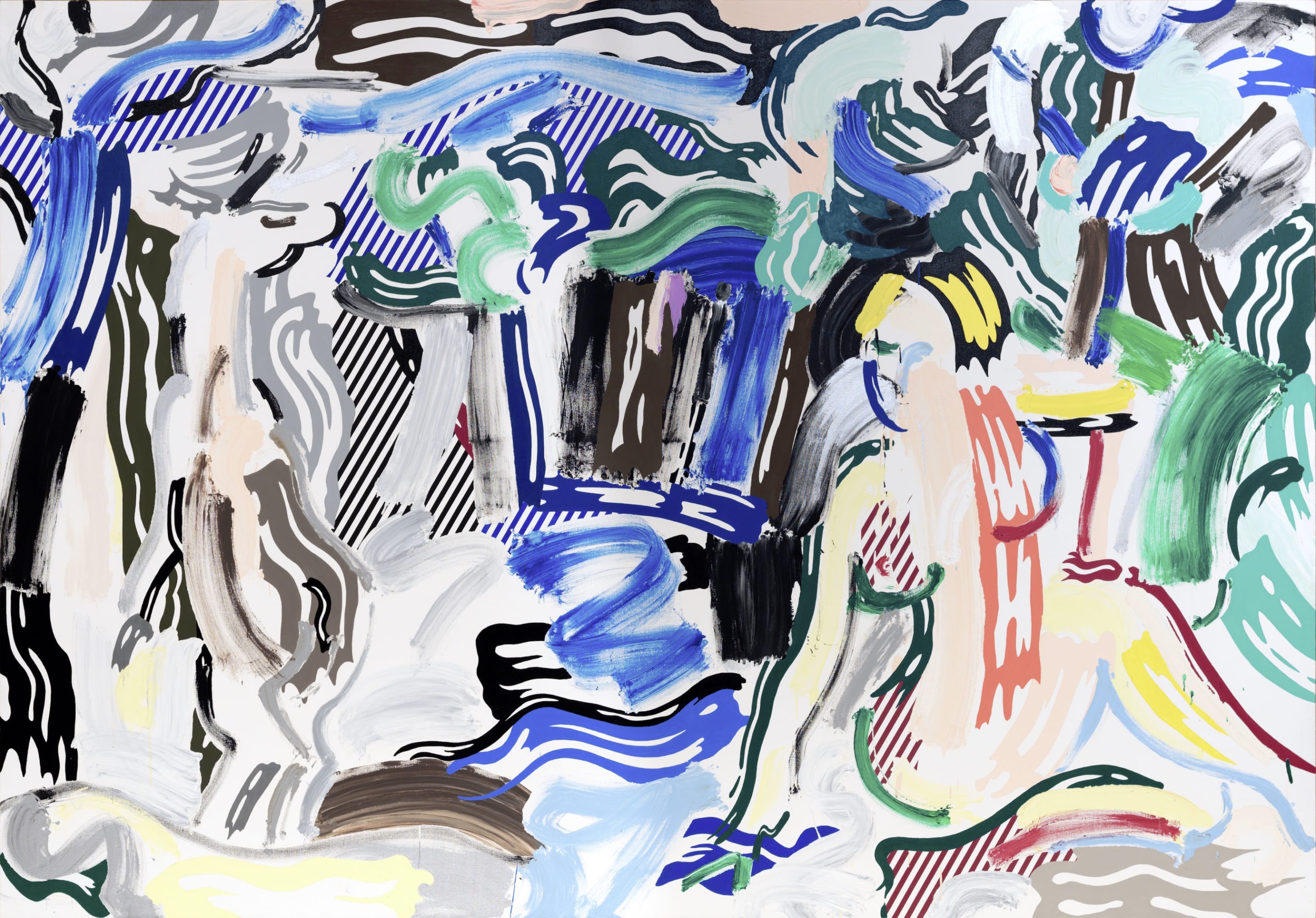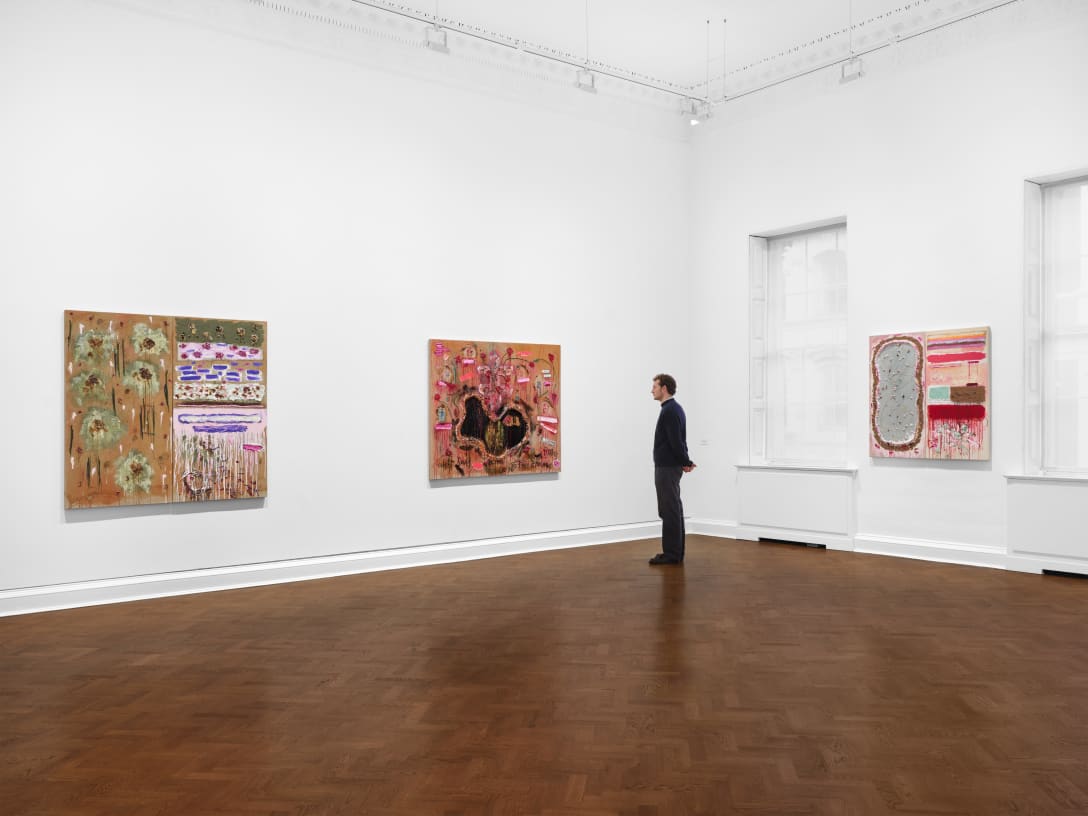Overview
Engaging with a new subject matter, the brushstroke-form, Lichtenstein refined and reinterpreted the techniques and palette of his iconic Pop style.
Brushstrokes in a painting convey a sense of grand gesture; but in my hands, the brushstroke becomes a depiction of grand gesture. Roy Lichtenstein
A leading pioneer of the Pop Art movement, Roy Lichtenstein’s innovative use of the brushstroke, reducing the form of the painted stroke to its simplest expression, led to a new visual language which he elaborated to reach new heights in the 1980s. Engaging with a new subject matter, the brushstroke-form, Lichtenstein refined and reinterpreted the techniques and palette of his iconic Pop style.
The Loaded Brush at Galerie Thaddaeus Ropac Salzburg, an in-depth exhibition focusing on this seminal period of Roy Lichtenstein’s career which follows numerous historic and institutional shows in the United States, brings together rarely seen works that span major figurative and abstract paintings, sculptures, collages and drawings. Together, the brushstroke sculptures and paintings constitute a significant portion of the artist’s oeuvre and demonstrate some of the guiding interests of Lichtenstein’s ongoing artistic development across a variety of materials.
A highlight of the exhibition, now exhibited for the first time in Europe, is one of Roy Lichtenstein’s most daringly expressive works: Artemis and Acteon (1987), inspired by Titian’s masterful rendering of the Greek myth painted in 1556–1559.
Executed with superb craftsmanship, Lichtenstein’s painting is characterised by its celebrated subject matter, rich colour contrasts and rhythmic brushwork, a combination shared only by Lichtenstein’s most iconic Cartoon Brushstroke Figure works of the 1980s. A flawless union between the classical, the modern, and the contemporary,Artemis and Acteon is an outstanding example of Lichtenstein’s timeless engagement with the history of art, demonstrating his remarkable ability to bring together past historical styles and pave the way for conceptual commentary on painting itself.
It [the Brushstroke] was the way of portraying this romantic and bravura symbol in its opposite style, classicism. The Brushstroke plays a big part in the history of art. Brushstroke almost means painting or art. Roy Lichtenstein, 1991
Lichtenstein extended these technical explorations beyond figurative subject matter to develop a number of iconic landscape paintings, such as the major piece dating from 1987, River Scene. Completed towards the end of the decade, River Scene moves further into the realm of abstraction whilst retaining its communicative power. Through his daring presentation of both narrative subject in Artemis and Acteon and traditional landscape in River Scene,Lichtenstein challenged audiences to re-engage with classical subject matter, revitalised by his innovative brushwork, just as his celebrated Benday dot works recast images drawn from commercial art. By isolating elements of the overall composition, Lichtenstein highlights how they work together on the painted plane, addressing the relationship between vision, perception and image, and revealing the fundamental function of the brushstroke in figuration.
Traditionally understood as showing great technical skill and brilliance of execution, Roy Lichtenstein’s ‘bravura’ is evidenced through a number of previously unseen works on paper included in the exhibition, complementing and elaborating upon the artist’s canvas paintings either as direct preparatory studies or independent explorations of the painted stroke, displaying a unique deftness of hand and attentiveness to form that sets him apart from his peers.
It was through Roy Lichtenstein’s ‘bravura’ that he invested his simplified subject matter with a rhythm and energy that enabled him to extend his flattened brushstrokes beyond the canvas, through the three-dimensional, and into the monumental. Moving beyond the plethora of techniques used in his painted explorations and into the realm of sculpture, he composed a number of free-standing, three-dimensional brushstroke pieces throughout the 1980s which took the form of medium-sized works, such as Endless Drip (1995) and eight further sculptures featured in the exhibition, as well as his public sculptures executed at ambitious scales.
Lichtenstein’s principle emerged clearly – that of extracting from the typical historical styles a cliché that could be interpreted as irony, but also as a distillate, a crystallisation of a specific application of the brush-stroke. – Siegfried Gohr, author of the essay written on the occasion of this exhibition for the accompanying comprehensively illustrated catalogue, and director of the Josef-Haubrich Kunsthalle, Cologne, when it hosted the celebrated Lichtenstein 1970-1980 focus retrospective in 1982. Curated by Jack Cowart, the exhibition included important works by the artist from the Ludwig Collection.
THE DEVELOPMENT OF ROY LICHTENSTEIN'S BRUSHSTROKE-FORM
Although Lichtenstein had begun depicting the brushstroke two decades prior, the 1980s saw him refine, home in on and liberate his subject – in both painting and sculpture – to produce multiple brushstroke-forms that clearly delineated his principle aesthetic and remained fundamental to his practice throughout his career. The late 1970s in America, largely dominated by Minimal and Conceptual art, had paved the way for a radical revival and re-evaluation of painting, and Lichtenstein’s brushstroke-forms were an instrumental component in the unprecedented shifts that swept the art world over the following decade.
Juxtaposing both stencilled brushstrokes and freely applied paint on canvas, Roy Lichtenstein produced a number of paintings that drew directly from his predecessors including Pablo Picasso, Paul Cézanne and Willem de Kooning. Dissecting and responding to their methods, he delved into unexplored painterly possibilities while simultaneously distancing each piece from the meaning of its original. While the modernists maintained the notion that the subject of a painting is painting itself, Lichtenstein extended this idea to transform the vehicle of the painting’s expression into its very subject.
Employing a wide repertoire of methods, Lichtenstein translated the gestural strokes of Expressionism into a Pop Art idiom: flattening the brushstroke-form by rendering it in bold, unmodulated colours with heavy black outlines. Denying any presence of the artist’s hand, Lichtenstein’s paintings rejected the subjective emotion of his Expressionist forbears and Neo-expressionist contemporaries, while keenly embracing the concept of ‘bravura’: his brushstrokes embodied both the joy and technical finesse with which he engaged in the process of painting itself – free from personal narrative yet imbued with pleasure and dexterity, executed with a meticulous attention to detail and refined prowess.
ROY LICHTENSTEIN'S BRUSHSTROKE REALISED IN SCULPTURAL FORM
I did isolate Brushstrokes in 1965 and used cartoon brushstrokes to depict subject matters in the 80s. I also did Brushstroke sculptures in bronze and wood to make them more palpable. … the Brushstroke, it is just an idea to start with, and painting it makes it more concrete, but when you do it in bronze sculpture, it becomes real and has weight and is absurd, contradictory and funny. Roy Lichtenstein, 1991
Roy Lichtenstein’s sculptures of the ’80s developed and parodied the gestural style of Expressionism, as signified by the brushstroke, translating the fluidity of paint into a permanent, metallic medium. Extracted from their canvas support and subverting the medium’s conventional volume and mass, the brushstroke sculptures take the singular, sweeping components identified in his Expressionist-inspired paintings and soar vertically in three-dimensional, dynamic yet flat brushstroke-forms, exploring new concerns with composition, spatiality and experience.
Here emerges something that can equally be observed in many paintings of this phase: a rhythm, which gives them a musical tone. An ascending motion is interrupted, as though a melody were paused on one chord, then continues to flow upwards to a temporary conclusion that suggests further energy. These early 1980s works reflect on the constructivist power of just a few brush-strokes. Even in these simple details there is enormous energy that can soar into monumental works. Siegfried Gohr
We thank Dorothy Lichtenstein and the Lichtenstein family, Jack Cowart and the Roy Lichtenstein Foundation and Barbara Bertozzi Castelli and the Castelli Gallery















































































































































































